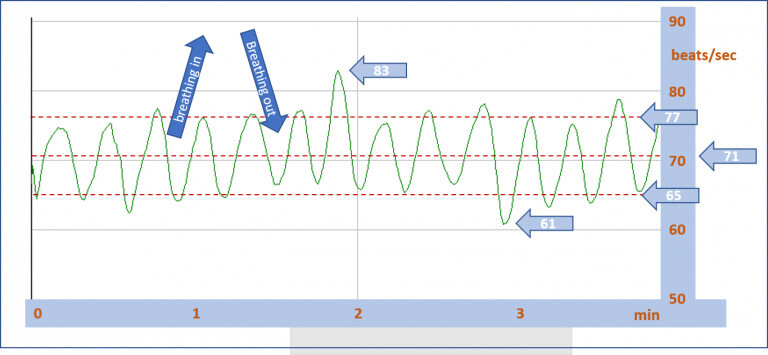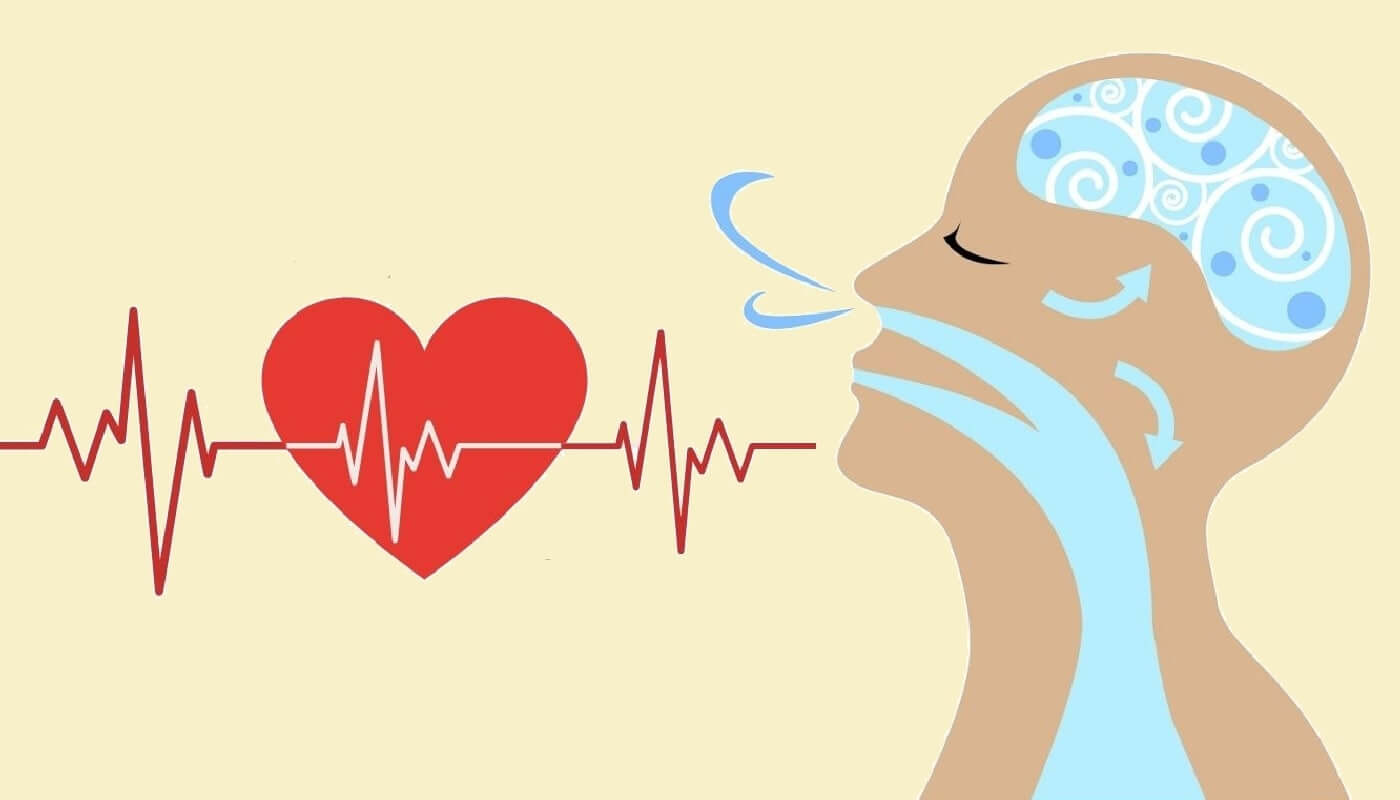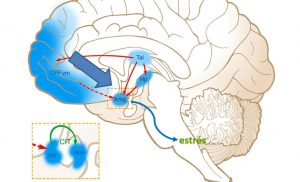Heart rate, the rhythm of the heartbeat, is related to breathing. Knowing how it works helps us better understand the neuroscience of behaviour and have more resources to improve our well-being. We will see how the brain and the body are connected by the autonomic nervous system and we will give our opinion on two neuroscience articles.
Two summaries that we have read in Neuroscience News serve us as a starting point for writing this article. In it we will inquire into the connection between the brain and the body. Specifically, in the relationship between the brain, heart rate and breathing. Let us remember that the purpose of NeuroQuotient® is to have more options for well-being from the knowledge of psychobiology and behavioural neuroscience.
The post is quite long. For a faster reading, we can follow the bold subtitles.
We start by looking at what the Neuroscience News abstracts are about.
Breathing and Fear
‘Breathing in through the nose activates the amygdala, the brain centre of fear’.
The first summary is from 2016. The title: Rhythm of Breathing Affects Memory and Fear. It is based on an original publication of Christina Zelano et al in The Journal of NeuroSecience: Nasal Respiration Entrains Human Limbic Oscillations and Modulates Cognitive Function.
Individuals identified a fearful face much more quickly if it appeared to them while breathing in than when breathing out. Furthermore, they were much better able to remember an object if it was presented while inhaling. This always happened when breathing through the nose, if they breathed through the mouth the effect disappeared.
They found a marked difference in the activity of the amygdala (limbic fear centre) and the hippocampus (memory centre) between inhalation and exhalation. The activity of the amygdala and hippocampus was greater when breathing in.
So, we see that breathing, and differently when inhaling and exhaling, influences the brain and human behaviour.
Let’s leave it here for now and see the other article.
Heart rate and depression
“With depression the heart rate is higher and at night its decrease is impaired’.
The other summary is more recent. September 2020. The title: Depression Risk Detected by Measuring Heart Rate Changes.
The original source was an interview to Dr Carmen Schiweck (Goethe University, Frankfurt), about a study that was going to be presented in the Virtual Congress of European College of Neuropsychopharmacology.
They studied two groups of 16 participants. One made up of people with depression and a control group with healthy people. Their heart rates were measured for 4 days and 3 nights. The depressed participants were then given ketamine or a placebo.
They found that participants with depression had a higher heart rate (10-15 beats per minute) and less variability, as previous research indicated. Normally, the heart rate is higher during the day and lower at night; with depression it seems that this nocturnal decrease in heart rate is impaired.
After ketamine treatment they found that both the heart rate and its variability of the previously depressed patients were much closer to the values of the control group.
We are not going to go into if ketamine can be a good treatment for depression. We simply keep the idea that the rhythm of the heartbeat has a close relationship with depression. Logically, it will also have it with the depression associated neuro behaviours.
Brain and body connection
“The autonomic nervous system, and the somatic nervous system, connect the brain and the body.”
To understand what has been said so far, it is necessary that we see the connection between the brain and the body.
The brain (encephalon and spinal cord) connects to the body through the peripheral nervous system (PNS) which consists of two components: the somatic nervous system (SNS) and the autonomic or vegetative nervous system (ANS).
The somatic NS receives information from the sensory organs and controls the movements of the skeletal muscles. But, for what we are dealing with, the relationship between brain and heart rate taking into account breathing, we will stay with the ANS (autonomic nervous system). The function of the ANS is to maintain the balance of the internal environment (homeostasis) by regulating automatically, the cardiovascular, respiratory, digestive, excretory and thermoregulatory mechanisms.
The ANS (autonomic nervous system) has two branches, the sympathetic and the parasympathetic
‘The sympathetic branch is involved in energy expenditure and stress. The parasympathetic branch participates in the recovery of energy and rest ‘.
The sympathetic branch is mainly related to activities associated with the expenditure of energy reserves stored in the body. Thus, the effects of sympathetic activity are more evident in situations of stress, exciting or fear, producing, among other changes, an increase in blood flow to skeletal muscles, stimulation of adrenaline secretion and, with it, a heart rate increase and, also, an increase in blood sugar levels.
The parasympathetic branch is related to activities involved in increasing the energy stored in the body, such as the activity of the digestive system.
In Table 1, we have some of the performances of the sympathetic and parasympathetic branches of the ANS. We see that while the sympathetic ANS accelerates the heart rate and dilates the bronchi, the parasympathetic NS has the opposite effect (it slows down the heart rate and makes ventilation difficult). Looking at the set of Table 1 we can understand that the sympathetic ANS is more involved in stress and energy expenditure and the parasympathetic in energy recovery and saving.
| Organ | Sympathetic branch | parasympathetic branch |
| pupils | dilation | constriction |
| saliva | inhibition | stimulation |
| lungs | ventilation relaxation | makes ventilation difficult |
| heart | accelerates heart rate | slows the heart rate |
| stomach | Inhibits digestion | stimulates digestion |
Full breathing cycles
So that we can better understand what we will discuss below, it is important that we remember how to do full breathing cycles.
Both in the practice of yoga, as in meditation, as in practicing relaxation techniques, they teach us to do full breathing cycles.
Complete breathing cycles consist of the following (Fig 1 serves us as a guide):
After thoroughly expelling the air from the lungs,
- We breathe in slowly and deeply, taking the air through the nose and bringing it to the lower part of the lungs. We notice how the abdomen is swelling.
- We continue to breathe in, bringing air to the upper part of the lungs. We notice how the chest swells.
- We begin to exhale, now in reverse order, first removing the air from the upper part of the lungs.
- We continue to remove the air from the abdominal part of the lungs.
- We start another cycle: inhaling (abdomen, chest), exhaling (chest, abdomen).
Let’s leave it here for now, then we get back to it.

Figure 1. Complete breathing cycle. Filling the lower part of the lungs (1), the upper part (2), letting the air out of the upper part (3) and the lower part (4).
Heart rate variability is continuous, not just between day and night.
‘When breathing in the heart speeds up and when exhaling it slows down’.
In the second summary that we quoted at the beginning (depression and heart rate), they told us that in people with depression the heart rate was higher. In addition, at night the rhythm of the heartbeat tends to drop and in people with depression it does so to a lesser extent.
But, is that the heart rate is not constant, it oscillates continuously! When taking our pulse to measure our heart rate, we count the number of beats in a minute. But, in this way, we are measuring an average value! Actually, the time interval between consecutive heartbeats is not kept constant.
It happens that when breathing in the heart speeds up and when exhaling the heart rate slows down. We can test this by doing a couple of cycles of full breathing while taking our pulse with our thumb on the wrist. We will see that as we breathe in, the time interval between consecutive beats shortens. On the contrary, when the air is released, the pulsations become more spaced.
A more accurate check of how the heart rate varies with breathing.
We can check that the heart rate fluctuates with respiration with the Doc Childre HeartMath Freeze-Framer application that we have been using since 2005. (In HeartMath you will now find more current applications for smartphones).
Freeze-Framer detects the heart pulse with a sensor placed on a finger (or on the earlobe). The computer application calculates the instantaneous heart rate from the time interval between every two consecutive beats.
We have measured the instantaneous heart rate for near 4 min while doing full breath cycles. In Fig 2, we see that the heart rate has been following an almost sinusoidal curve. In each cycle, the frequency has increased as breathing in and has decreased as exhaling.

Figure 2. Heart rate with consecutive full breath cycles. When you breathe in, the rhythm of the heartbeat increases and when you exhale it decreases.
During the time of the test, the average of the peaks of the curves was 77 heartbeats per second and the valleys were 65. The average heart rate was 71 beats per second. That is, if we had divided the total beats by time in minutes, the result would have been 71 heartbeats / second.
The rhythm of the heart and the autonomic nervous system
‘When breathing in, the sympathetic branch of the ANS accelerates the heartbeat rate and, when exhaling the parasympathetic branch slows it down’.
But there is something even more interesting. Let’s go back to Heartmath and Doc Childre et al. Specifically to the book ‘The Hearthmath Solution’ (HarperCollins Publishers, 2000).
They tell us that when we have an almost sinusoidal heart rate curve, like the one in Figure 2, it is because the sympathetic and parasympathetic branches of the ANS are in balance. The sympathetic branch accelerates the frequency of the heartbeats and the parasympathetic slows them down; one after the other and so on.
We cannot fail to introduce the principle of The HeartMarth Solutions technique. They explain that the variability of the almost sinusoidal heart rate (cardiac coherence) is achieved when we are in positive emotions such as appreciation, love and care for others. When we feel emotions such as frustration, anger, etc. the heart rate goes up and down irregularly, and a broken line is recorded.
In addition, for HeartMath, cardiac coherence and being in the zone are synonymous. In NeuroQuotient® we talked in another post about being in the Zone and Flow as similar terms.
But, for this article, the most important thing is that we can achieve and train cardiac coherence by practicing conscious full breathing as well.
A summary of what was seen,
Before going to the conclusions and seeing how we can take advantage of these ideas to improve our satisfaction and well-being, it is convenient that we collect a summary of what has been discussed so far. Just as headlines:
- Breathing in through the nose activates the amygdala, the brain centre of fear’.
- “With depression the heart rate is higher and at night its decrease is impaired’.
- “The autonomic nervous system, and the somatic nervous system, connect the brain and the body.”
- ‘The sympathetic branch of ANS is involved in energy expenditure and stress.
- The parasympathetic branch participates in the recovery of energy and rest ‘.
- The heart rate increases when breathing in and decreases when breathing out.
- When inhaling the sympathetic branch of the ANS is more active and when exhaling the parasympathetic branch works.
Conclusions
The understanding of neuroscience provided by NeuroQuotient® allows us to comment on the following:
In previous posts (about stress or the relationship between memory and behaviour) we said that when our brain perceives a threat signal, the amygdala is activated and then the stress fast track (sympathetic ANS). In this way we are ready to face the threat (fight) or run away (flight).
Now we see (point 1, previous section) that the reverse also happens. When we breathe in, the amygdala is activated … because we activate the sympathetic ANS.
Another thing. Considering what we have seen, we must think that the sympathetic ANS is more active during the day and the parasympathetic one at night. Going to point 2 above, it is not risky to think that, with depression (and even more so with anxiety) the heart rate is higher and decreases less at night due to a lack of efficiency of the parasympathetic ANS. And, yes, also because the sympathetic ANS is more active than it should be.
How can we take advantage of what we have learned?
The most important thing is that we see that not only the unconscious brain influences the body, but by directing the breath consciously, we can influence the heart rate and our emotional state.
With full breathing we can train, for example, the balance between the sympathetic ANS and parasympathetic ANS and the cardiac coherence. This balance between the two ANS branches should come naturally, but unfortunately, it tends to be more inclined towards the sympathetic branch.
Finally, there is something else that we have not gone into, but that will help us. We have seen that the heart rate accelerates more when inhaling and in the second stage of complete breathing (when filling the upper part of the lungs with air). This reminds us that when we breathe mainly with the chest, we tend to do it faster, the sympathetic ANS is more active and the heart rate is higher. For this reason, to relax, it is important to practice abdominal breathing.
By consciously breathing we can, for example, start with a few full breaths and then focus on getting air in and out mainly from the lower lungs. That is, practicing abdominal breathing.




